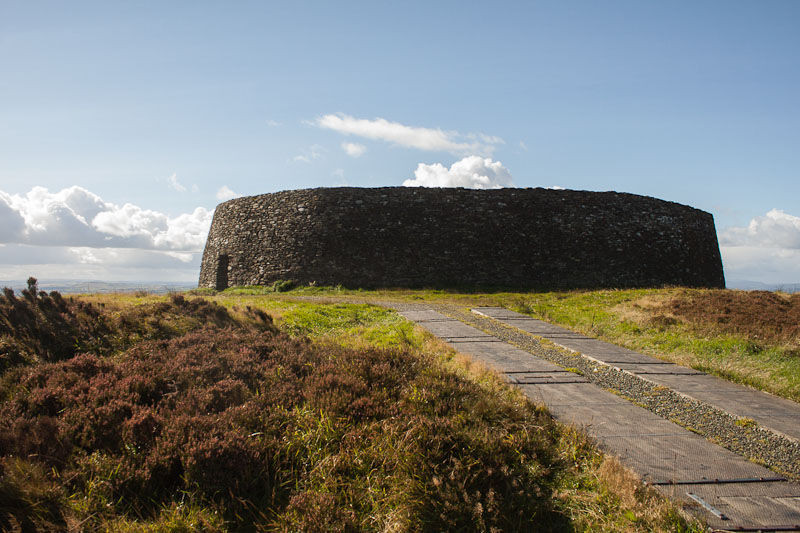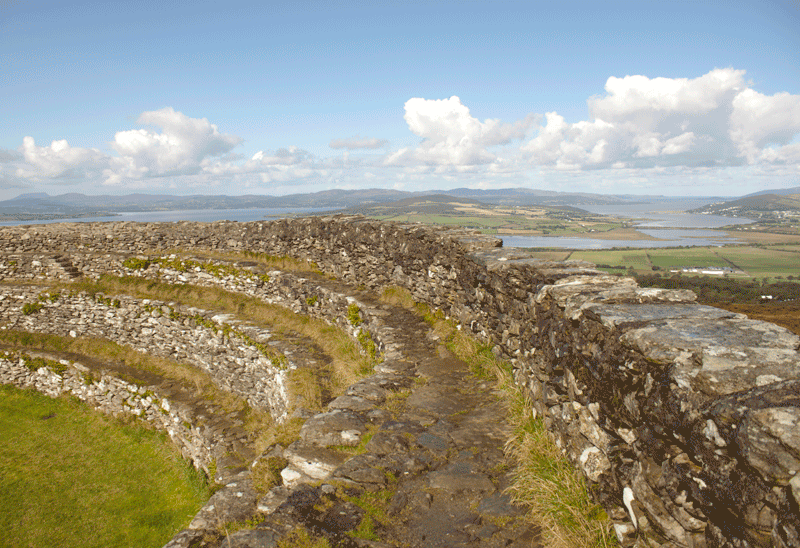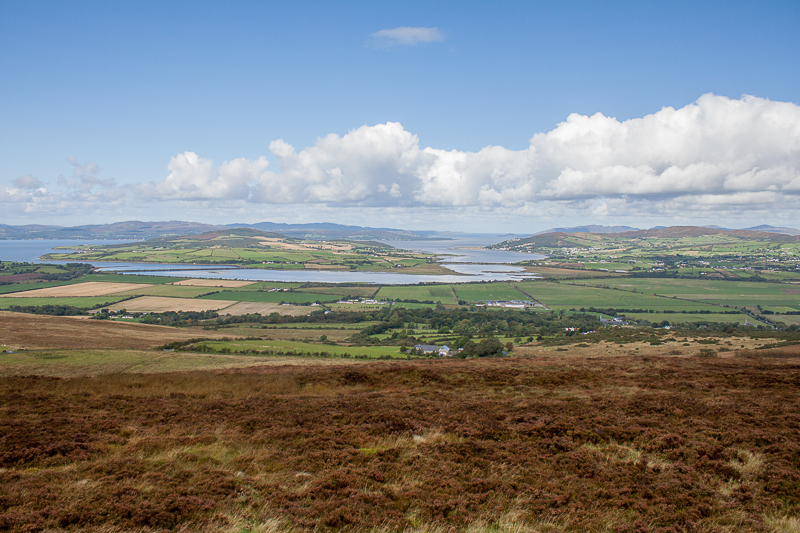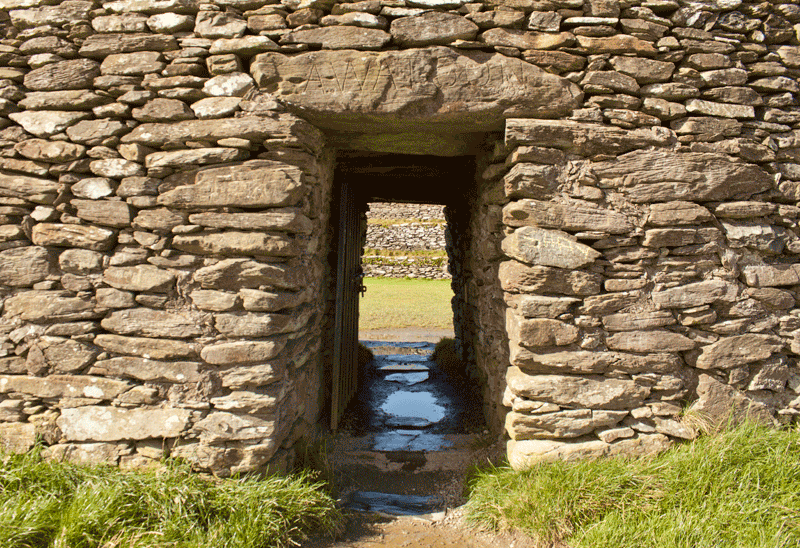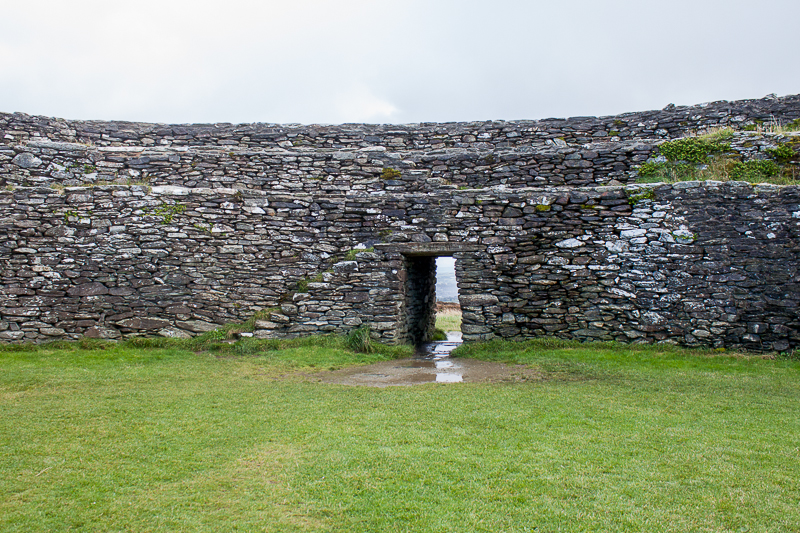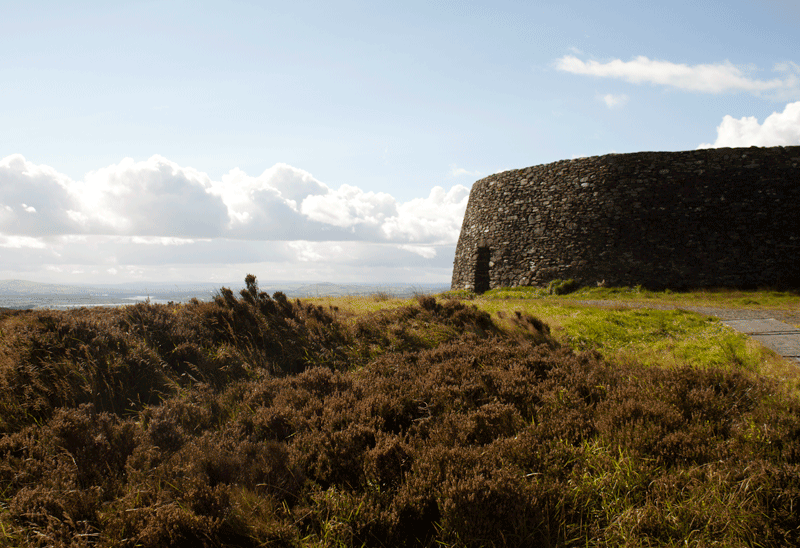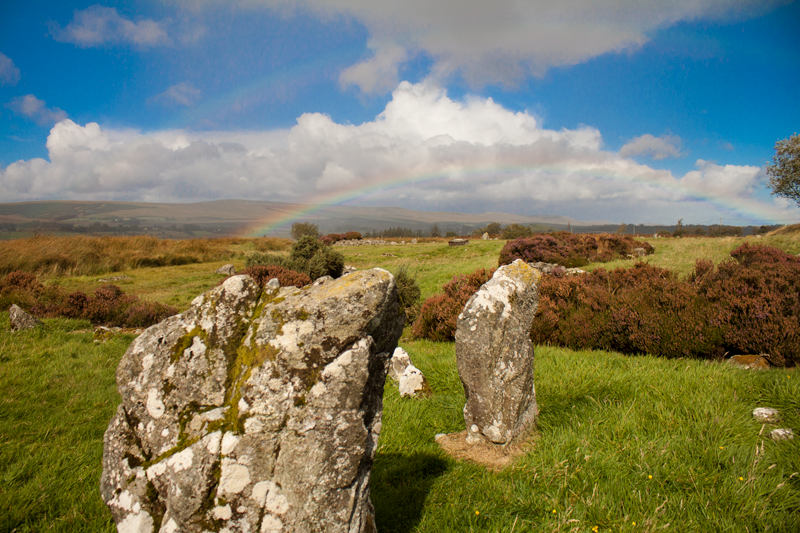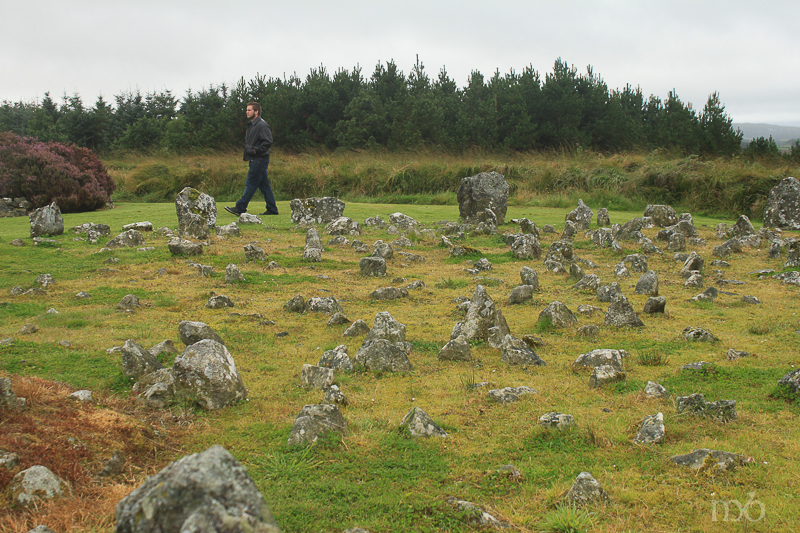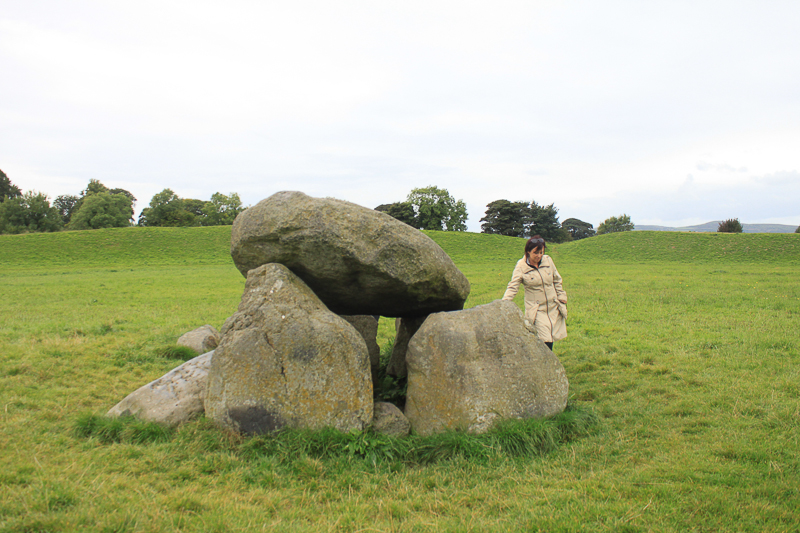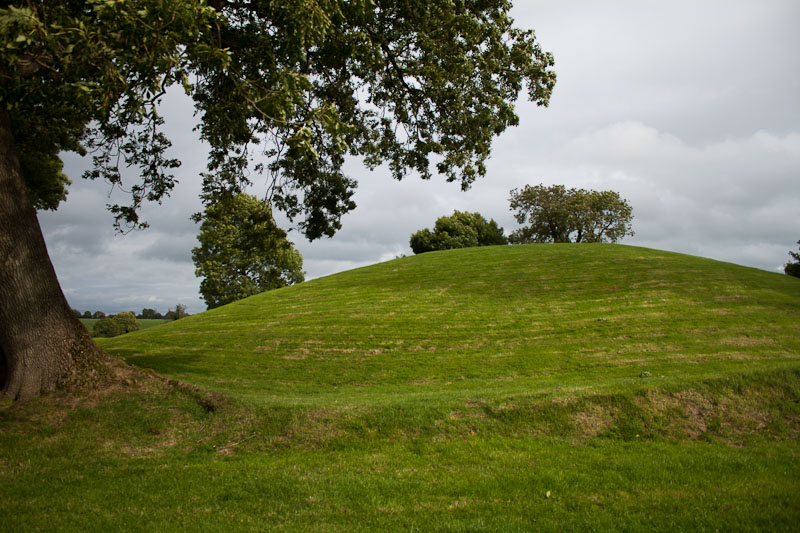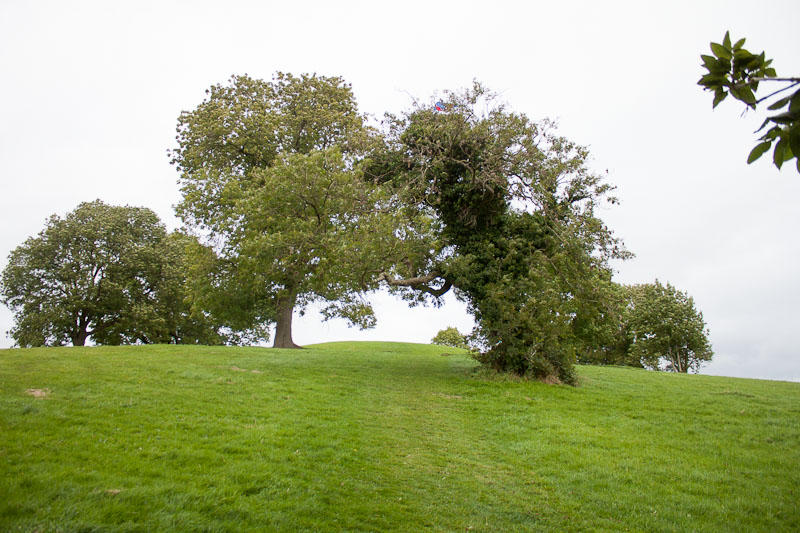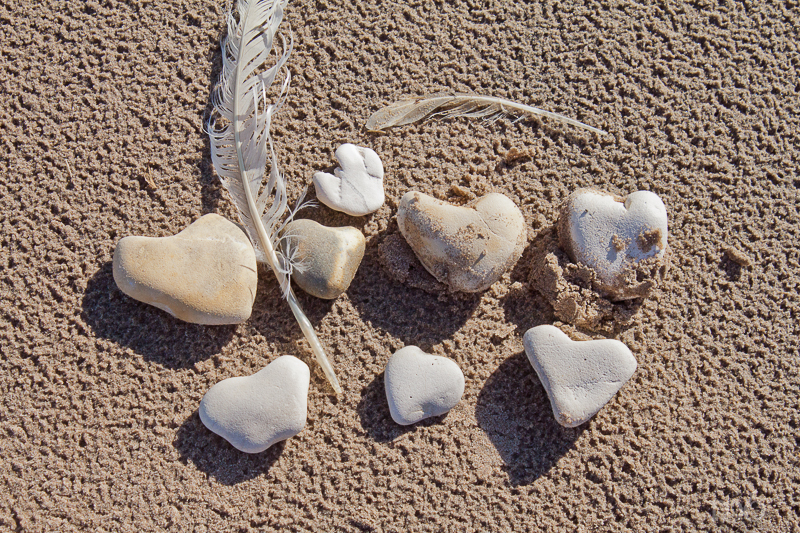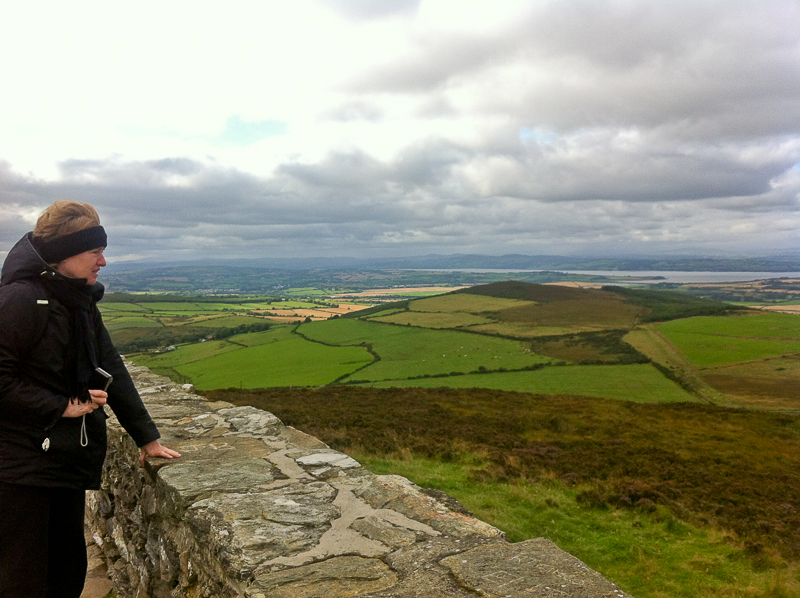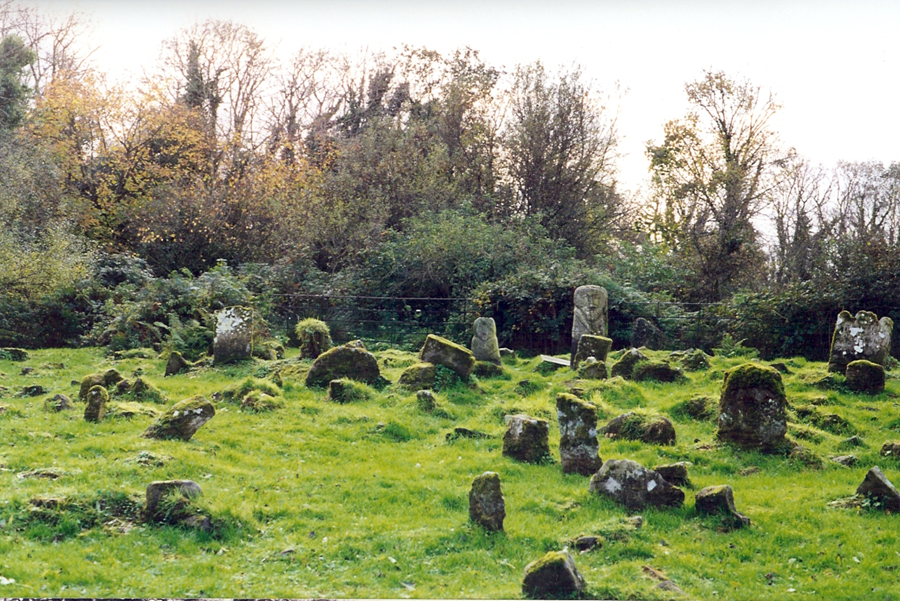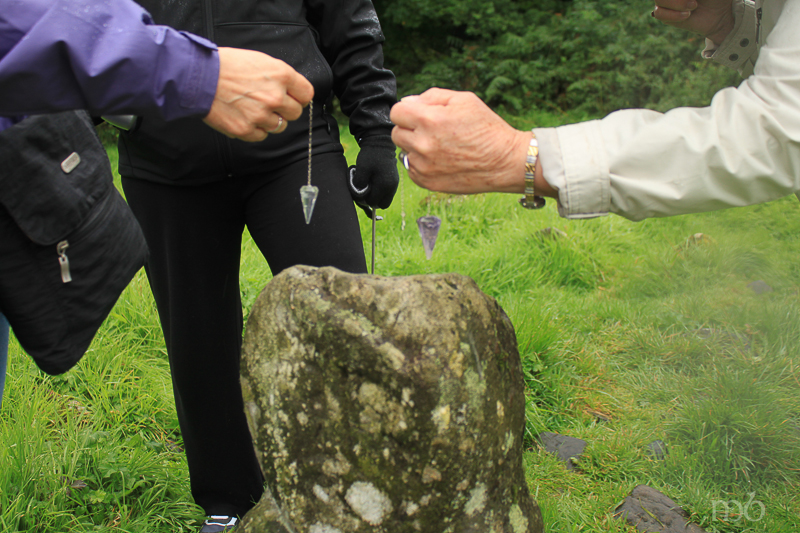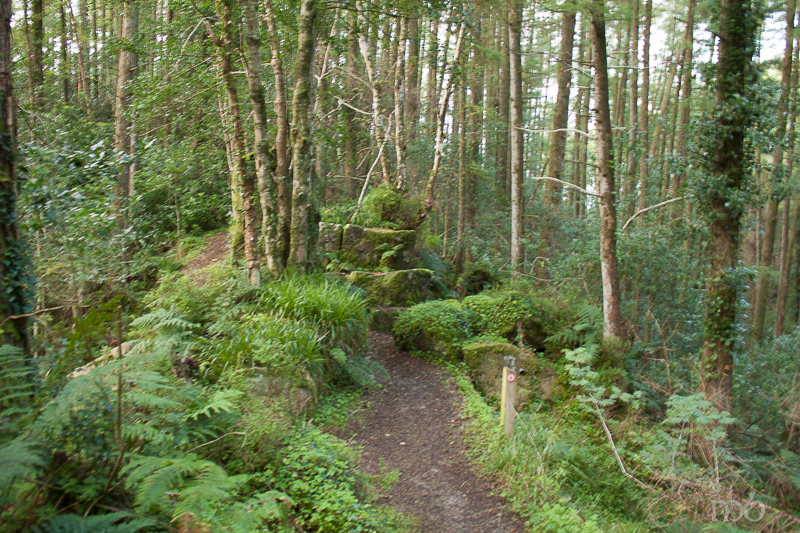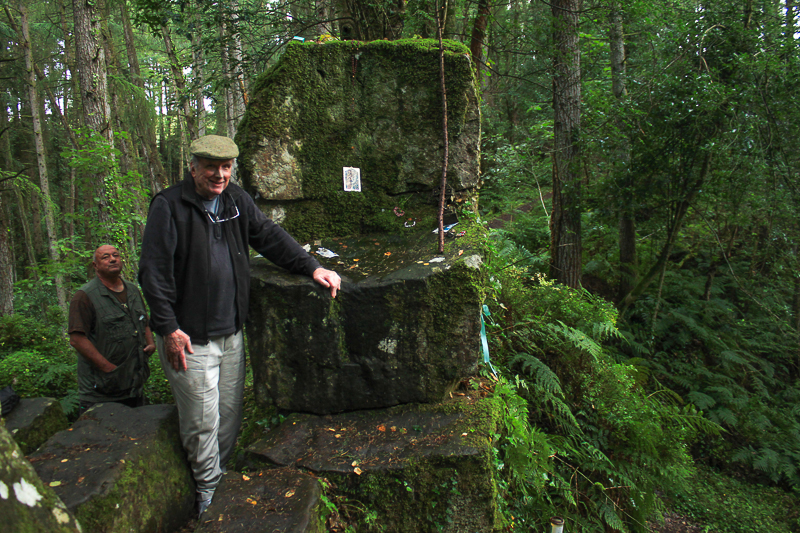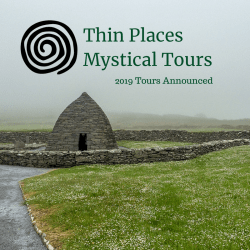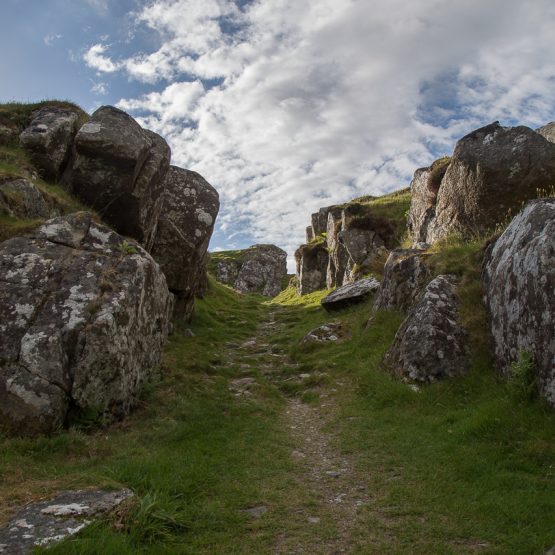Grianán of Aileach – the Sun Palace
Grianán of Aileach or Grianán Ailligh is a cashel on the Inishowen Peninsula in County Donegal. Also known as the “Sun Palace,” it was the royal citadel of the northern Ui Néill (O’Neills) from the 5th to 12th century.
The Cashel
The cashel dates to the third century and archaeologists suspect it could have been built on a former Neolithic sacred site or burial mound. Experts in Irish culture and heritage believe that the mound was used for ritual purposes as far back as 1700 BC and was the center of one of Ulster’s ancient kingdoms – and later the political center of the ruling O’Neill’s and later the O’Donnells. This would have been the royal center, where kings were crowned and rituals carried out as well as a defensive structure.
Though the actual ring fort was probably built in early Christian times, the three concentric rings surrounding the cashel as well as artifacts discovered in the surrounding rings suggest this spot was used for ritual much earlier. The cashel itself is 77 feet in diameter and its walls are 13 feet thick with chambers embedded. Inside the circle are stairways built into the inside walls the lead to ringed seating areas – like an amphitheater. This seating gallery would hold hundred of people who could witness inaugurations and other ritual ceremonies.
The City of Derry’s website has a video embedded that was filmed inside the cashel and shows a reenactment of a medieval celebration
From the top of the ring one can see for miles in every direction. Counties Tyrone, Donegal and Derry are in view with mountains, cliffs, open pastures, villages and beaches. Lough Foyle and Lough Swilly, the two bodies of water that flank the Inishowen Peninsula swirl about in that landscape. The peninsula rolls out like a blanket from this vantage point, eventually vanishing in a misty gray horizon (on a sunny day, that is). It’s easy to understand how the cashel on dominated the region and became as the political center. Its remarkable disk-image capping a hill 800 feet above sea level is visible to so much of the surrounding countryside.
Tied to Celtic Mystery
Folklore suggests that prior to the cashel, this hill was associated with deities linked to the sun. In Irish “Ail” refers to stone. Grianán in Irish means “sunny spot” or sun temple. So the name could refer to a stony sun temple or palace. But according to author Cary Meehan who wrote Sacred Ireland, it can also mean sunny disposition or of the sun. In Celtic mythology Grainne was the sister of Aine – goddes of the sun, and though Grainne was known as goddess of corn or grain (springs from the earth after being nurtured by the sun), both sisters are said to have been birthed by a sunbeam or “of the sun.”
There is also a tradition that the temple was built by Daghdha, the good god or god of the earth. He was known as the King of the Tuatha dé Danann, a race of supernatural beings descended from the Goddess Danu. They inhabited Ireland before the Celts. This tradition has Daghda building the fort to protect the grave of his son. A variation tells of giants building the hill and the Grianán on top a residence for the shining ones who gave birth to the children of the sídhe. All of these traditions link the hill and the fort on top with supernatural beings, to unseen energy and power and a link to the Otherworld.
Cashels were built for defensive purposes, but circles are also linked to Irish ritual and spirituality. The shape represents a deeper meaning. Stone circles, carved spirals on implements and burial stones, circular mounds covering passage tombs indicate this. There was also a later belief that circular buildings had no corners for evil entities to hide. Thus one can’t dismiss the spiritual importance of Grianán of Aileach, even though the cashel marked it as a secular site. The traditional beliefs embedded in the Irish life permeated all they did. This circular fort sitting atop three concentric circles on a circular hill was built with circles in mind. And the site has a powerful energy about it.
Originally the cashel had been the stronghold of the 4th century chieftain, Niall of the 9 Hostages. Later it became the stronghold of the O’Neill kings and the O’Donnells. The cashel was mostly destroyed in 1101 by the king of Munster, Murtagh O’Brien and his army in retaliation for the O’Neill’s destruction of his palace in Clare (Kincora). After they sacked Grianán of Aileach, Murtagh O’Brien told his army of a thousand men to each take a stone from the cashel with them so that the fort could not be rebuilt.
The cashel was later restored again in 1837 by a Dr. Bernard from Belfast. And in 2007 the Irish Office of Public Works restored it to the excellent condition it is in today. Some say it is over restored. But over-restoration has not blocked the ancient energy that still apparently seeps from the ground and surroundings.
The Energy Linked to Grianán of Aileach
Irish Musician, Tommy Makem in his book Tommy Makem’s Secret Ireland wrote about his experience in trying to tape a television interview with Derry songwriter, Roy Arbuckle inside the cashel . Arbuckle laughed and told Makem that they’d never be able to record inside the walls. Makem couldn’t see any reason why it shouldn’t work.
But it didn’t work. Within a minute the sound engineer notice erratic movements on the meters which he couldn’t correct. The struggle continued for an hour and a half. They finally eked out 15 minutes worth of an interview, and as soon as they were done, all the batteries went dead. Somehow, Arbuckle expected this difficulty. Makem writes, “Roy seemed to understand the workings of some hidden forces in this magical place. He was chucking all the way back to Derry.”
It is true that Grianán of Aileach has an energy about it. One feels it on the walk up the hill to reach the cashel. It’s mad windy on that hilltop but as soon as you enter the linteled doorway into the ring, all the sounds of wind cease. Everything is suddenly still, and there is a strange silence. As soon as I crossed that threshold my imagination moved immediately to those who were in this space before… the sounds, the voices, the cheering, the shouting almost as if an old movie was playing in my head.
The entrance into the cashel is a threshold the opens into a place of different energy.
Over-restored or not, that energy is still present and the views of the surrounding landscape are some of the best I’ve seen in Ireland. Standing on the top level of the cashel ridge I surveyed the breadth of three counties – their pastures, mountains and Loughs Foyle and Swilly. The oneness of Ireland then and now is knitted together in that view.
One can see the approximate location of Rathmullen, a village on the west bank of Lough Swilly. It was from there that Hugh O’Neill and Rory O’Donnell left on a French boat bound for Spain one midnight in September of 1607. With 90+ relatives they sailed out of Lough Swilly changing the Irish social and political landscape forever. It marked an end to the old Gaelic order. An order of Chieftains and clans and common beliefs and the practice of rich traditions rooted in an ancient time.
And behind the fleeing earls was Grianán of Aileach, a remnant of old Ireland. In its time it was a great royal center, second to the Hill of Tara. An ancient road links them to each other. There is a legend of a cave in the hill beneath the cashel where the horsemen of the Great Hugh O’Neill rest in a magic sleep in full armor, mounted on their horses. The sleeping spell will only be broken when the next destined leader of Ulster arrives to lead them to victory.
So it seems there’s still a little magic left at Grianán of Aileach.
Sources used for writing this post:
A Traveler‘s Guide to Sacred Ireland by Cary Meehan
Tommy Makem’s Secret Ireland by Tommy Makem
Legendary Ireland by Eithne Massey
Mythic Ireland by Michael Dames
National and Historic Monuments of Ireland by Peter Harbison
Celtic Myths and Legends by Peter Berresford Ellis
Goddess Alive!: Inviting Celtic & Norse Goddesses Into Your Life by Michelle Skye
From Inishowen Buncrana Calling, the Heritage of Eoghain website by Brian Lace
7 Sites in Northern Ireland that Feed the Soul
I remember visiting Northern Ireland in the days when the military occupied the border equipped with machine guns and combat gear. I loved the north just as much then as I do now that the army, barbed wire and weapons are gone and a quiet peace has settled over the land. It’s a rugged, raw and ancient landscape that isn’t changed by external forces. Battles come and battle go, but the land and its sacred places remain unmoved and unchanged.
The North is my favorite region probably because the bones of the old landscape still peek through the sod without having to fight massive motorways and residential developments for attention. The ancients knew the energy was powerful here, and they marked many of their sacred places. While some markings have fallen away, the energy still lives. It continues to nourish the human spirit today just as it has for thousands of years.
Sadly, most tourists in the north pass by these special places not realizing that just off the road they’re driving on are stopping places where the traveler can walk in two worlds at once. Here are seven of my favorites in the North. You can’t approach this thin places and not be moved.
BEAGHMORE STONE CIRCLES – Co. Tyrone
I’m an earth energy novice. Like most common people, I can tell when a place has a sacred feel, but I can’t feel the energy move through the stones and emanate from earth the way some of my friends can. But Beaghmore radiates energy that even I can feel. It’s palpable.
Beaghmore is a series of seven stone circles set in a clearing at the edge of the Sperrin Mountains in County Tyrone. Six of of the circles are paired and one stands alone. The circles date back to 2000 BC. Artifacts excavated from the site suggest ritual activity 1000 years before that.
Two interesting things about Beaghmore – The circle that stands alone has 800 jagged stones set in the center (known as Dragon’s Teeth) and one circle has a portal to the Otherworld. In the center of the circle with the portal is a recent burn mark in the center of scorched grass and earth. It is currently being used as a ritual site.
Read more about the mystical nature of Beaghmore on Maura Brooks’ blog.
THE GIANT’S RING – Belfast
Belfast gets a ton of visitors. But how many know that just outside the city is henge monument that predates the pyramids of Egypt? A henge monument is a circular enclosure with a ditch carved out inside the ring. A henge fort is the same circular enclosure on the ditch is on the outside making it easier to defend the fort.
The Giant’s ring is a henge monument with the ring and ditch easily identified. The earth ring is about 600 feet in diameter and in the center is a slight hill crowned by a five large stones that support a large capstone. It’s believed that these stones on the hill are what remains of a neolithic passage tomb. The area is now preserved and used as a park. The visitor can do a ritual walk around the ring and then examine the stones in the center. There is actually a 3 mile defined walk of the ring and surrounds that includes a bridge that dates back to the Stone Age and a historic woodland.
There is a lovely energy here.
NAVAN FORT – Co. Armagh
I knew about Navan Fort being the legendary stronghold for the Knights of the Red Branch and the place where the goddess Macha died giving birth to her twins. Also known as “Eamhain Mhacha” or the “twins of Macha,” Navan Fort was associated with pagan ritual for years.
But what I didn’t know was that the famous mound (130 feet in diameter and about 20 feet high) had a fire ritual history. About 94 BC a wood temple supported by large oak pillars was built where the mound is and burned on the site in ritual fashion. The ruins of the temple were covered up with stone and earth creating the mound we see today. Excavation showed that soil used in the covering of the temple came from other places – some quite distant. Today people return to soak in the energy of the mound which apparently is still quite active. There is also a tradition of rolling down the mound to in order to soak in the energy of the mound whilst giving one’s own energy back to the mound.
At the base of the mound is a fairy tree, an old oak that looks much like a dragon rearing up against an enemy.
The story of Navan Fort is well told during the guided tour. For the full experience, pay the money at the Visitor’s Center and take the tour. The guides are fabulous and there is much to learn from them.
WHITEPARK BAY – Co. Antrim
Everyone knows about the great tourist sites on the Antrim Coast – the Giant’s Causeway, Dunluce Castle, Carrick-a-Rede Rope Bridge and the Bushmills Distillery. Travelers visiting these places pass right by Whitepark Bay not realizing what a mystical site they’re overlooking.
Right between the Causeway and Rope Bridge, just off the A2 is Whitepark Bay. It has a car park and solid stairway that descends to the magical beach where the sand sings.
True.
The sand on the beach is mixed with chalk from the cliff face which gives it such a fine consistency that when the wind blows a certain way (which it inevitably will) one can hear the sand “hum” with vibration. The cliffs are gorgeous and tucked into their vegetation overgrowth are the remains of passage tombs. This space in the landscape was considered sacred to the ancients. This beach is a thin place. It’s a portal, a threshold to the Otherworld. A place for thinking, for connection with your higher self. One only has to walk it to know this truth.
I collect heart shaped rocks when I travel as souvenirs from my twin granddaughters. This usually takes an hour or more to find the perfect rock shaped like a heart. At Whitepark I set out looking for two heart shaped rocks and asked my friend Maura to help thinking we could save time. Suddenly they were everywhere. Within 10 minutes we found 8.
8 … a mystical number for sure. The number that symbolizes infinity, connection to the Creator, the Cosmic Christ, the totality of the Universe. Maura kept one for herself. I brought 7 home. On sits on my desk. A daily reminder of Whitepark Bay.
GRIANÁN of AILEACH and the INISHOWEN PENINSULA – Co. Donegal
Driving the circle around the Inishowen Peninsula is at least a half-day, if not whole day commitment. But why not commit? It is some of the most spectacular driving in all of Ireland. And unlike many of the other spectacular drives (Ring of Kerry, Sally Gap, Connemara Hills, Molls Gap) it isn’t so crowded with visitors and coaches. Even in the cold and the pouring rain, the Inishowen is gorgeous. At its base on the south eastern side is Grianán of Aileach, also known as the Sun Palace.
Grianán of Aileach was the ancient royal site for northern Ui Néil from the 5th to the 12th century. The now restored cashel dates to the 3rd century and caps three concentric earth rings. The panoramic views from the cashel of the peninsula, Loughs Foil and Swilly and the city of Derry are dizzying – especially if you’re balancing yourself on the top ridge of the cashel.
There is also a tradition that the temple was built by Daghdha, the good god or god of the earth. He was known as the King of the Tuatha dé Danann, a race of supernatural beings descended from the Goddess Danu. They inhabited Ireland before the Celts. This tradition has Daghda building the fort to protect the grave of his son. A variation tells of giants building the hill and the Grianán on top a residence for the shining ones who gave birth to the children of the sídhe. All of these traditions link the hill and the fort on top with supernatural beings, to unseen energy and power and a link to the Otherworld.
BOA ISLAND & CALDRAGH CEMETERY – Co. Fermanagh
This is place every mystic should visit before he or she dies. Walking into Caldragh is like passing into another world. It’s an ancient cemetery on Boa Island set on the north shore of Lough Erne. It is surrounded by hazel woods with a fairy tree at the entrance. The ground is lumpy due to all the old graves, marked with jagged stones now covered by grass. There are also new graves but no church indicating this particular spot is still a place of sacred reverence for the local community.
Caldragh Cemetery is most famous for its Janus figure, a stone figure likely dating to the 4th or 5th century that has a face carved on both sides (thus the name Janus who was the Roman god of two faces). The Janus stands about 4 feet high and many archaeologists and mystics have guessed at what the two-faced figure represents, but it’s all speculation. There is a great energy in the stone. A dangling a pendulum above this stone spins quickly, even for the beginner. And the quiet soul will find a peaceful rest and easy connection to the Otherworld here.
Poet and Northern Ireland native, Seamus Heaney memorialized the Janus figure in a poem.
JANUARY GOD
Then I found a two faced stone
On burial ground,
God-eyed, sex-mouthed, it’s brain
A watery wound.
In the wet gap of the year,
Daubed with fresh lake mud,
I faltered near his power —-
January God.
Who broke the water, the hymen
With his great antlers —-
There reigned upon each ghost tine
His familiars,
The mothering earth, the stones
Taken by each wave,
The fleshy aftergrass, the bones
Subsoil in each grave.
For me Caldragh is much like the Rock of Cashel. No matter how many times I visit, I always want to return.
ALTADAVEN WOOD & ST. PATRICK’S CHAIR – Co. Tyrone
Altadaven Wood or Favour Royal Forest is an old wooded area bisected by an ancient road known as the Sliabh Beagh Way which snaked through Counties Tyrone, Fermanagh and Monaghan. On that road is the Demon Cliff where there is a large stone throne-like chair straddling a narrow space on the road. The chair, and the well below it are now known as St. Patrick’s Chair. Legends tell of this being an ancient druidic site that St. Patrick came upon while walking the Sliabh Beagh Way. When he saw the pagan ritual being performed he raised his crozier and cast the demons (druids) off the cliff and claimed the sacred site for Christ.
The forest is one of those great “edges” in the world where one crosses over into something upon entry. It’s thick and the mystical walk to the chair is deeply shaded by fir trees and lined with ivy, holly and fern. And suddenly you’re at the chair. Tokens left behind are reminders of other pilgrims who walk to the chair with intentions in their hearts. Some say that if you sit in the chair and make a wish, your wish will come true within one year unless you tell someone. It’s worth the walk.
All of the sites mentioned above are featured on our DISCOVER THE NORTH mystical tour of Ireland’s thin places.
